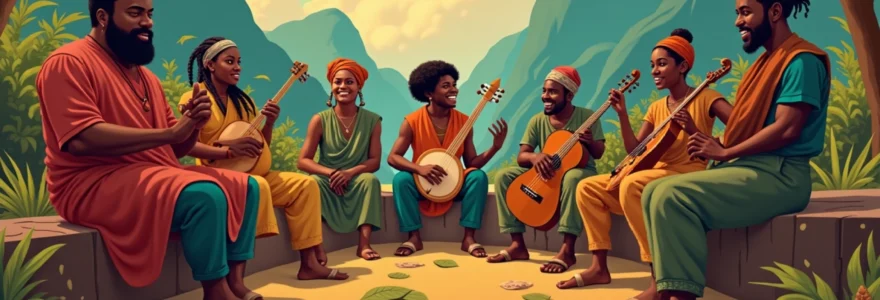Music serves as a powerful reflection of cultural identity, weaving together the threads of history, spirituality, and social dynamics. From the vibrant polyrhythms of African drums to the haunting melodies of European folk ballads, traditional music forms a rich tapestry that echoes the values, beliefs, and experiences of diverse communities. This exploration delves into the intricate relationships between music and cultural heritage, examining how various musical traditions have evolved, persisted, and continue to shape contemporary artistic expression.
African polyrhythmic traditions: djembe and talking drum techniques
At the heart of African musical traditions lies the concept of polyrhythm—the simultaneous use of two or more conflicting rhythms. This complex layering of beats creates a rich, textured soundscape that is both captivating and deeply meaningful. The djembe, a goblet-shaped drum originating from West Africa, plays a central role in many traditional ceremonies and celebrations. Its versatility allows skilled players to produce a wide range of tones, from deep bass to sharp slaps, each contributing to the intricate rhythmic patterns.
The talking drum, another iconic African instrument, takes rhythmic communication to new heights. This hourglass-shaped drum can mimic the tonal patterns of human speech, allowing drummers to convey messages across vast distances. In many West African cultures, the talking drum serves not only as a musical instrument but also as a vital means of long-distance communication, preserving oral traditions and historical narratives.
These percussion instruments are more than mere noisemakers; they are the heartbeat of African cultural expression . The rhythms produced by djembes and talking drums often carry deep spiritual significance, serving as a bridge between the physical and spiritual realms during religious ceremonies and rites of passage. The complex interplay of rhythms in African music reflects the interconnectedness of community life, where each individual contributes to the greater whole.
European folk music: modal scales and narrative ballads
European folk music traditions, while diverse, share common elements that distinguish them from their African counterparts. Modal scales, which predate the major-minor tonal system, form the melodic foundation of much European folk music. These scales, with their unique intervallic relationships, create distinctive sound palettes that evoke specific moods and cultural associations.
Narrative ballads, another hallmark of European folk traditions, serve as musical vehicles for storytelling. These songs often recount historical events, legendary tales, or aspects of daily life, preserving cultural memory and values through generations. The power of these ballads lies not just in their melodies, but in their ability to transmit cultural knowledge and moral lessons through engaging narratives.
Dorian mode in celtic jigs: “the irish washerwoman”
The Dorian mode, characterised by its minor third and major sixth, features prominently in Celtic music. “The Irish Washerwoman,” a well-known jig, exemplifies the use of this mode in traditional Irish dance tunes. The Dorian mode lends a distinctive, slightly melancholic flavour to the melody, even as the lively rhythm propels dancers forward. This interplay between mode and rhythm captures the essence of Irish musical culture, blending joy and wistfulness in a single, compelling musical expression.
Balkan asymmetric rhythms: bulgarian horo dance
Balkan folk music is renowned for its use of asymmetric rhythms, also known as aksak rhythms. These complex time signatures, such as 7/8 or 11/16, create a sense of perpetual motion and rhythmic tension. The Bulgarian horo dance music exemplifies this tradition, with its intricate footwork precisely matched to these uneven rhythmic patterns. These challenging rhythms reflect the region’s turbulent history and the resilience of its people, who have maintained their cultural identity through centuries of conflict and change.
Scandinavian nyckelharpa: evolution of the keyed fiddle
The nyckelharpa, or keyed fiddle, represents a unique development in European folk instruments. This Swedish string instrument combines elements of the fiddle and the hurdy-gurdy, featuring a keyboard mechanism that allows the player to change the pitch of the strings. The nyckelharpa’s rich, resonant tone and its capacity for both melody and drone make it a versatile instrument in Scandinavian folk music. Its evolution over centuries mirrors the adaptability of Nordic musical traditions, blending innovation with respect for historical practices.
Preservation through oral transmission: griots and troubadours
The preservation of musical traditions often relies on oral transmission, with specialised performers serving as living repositories of cultural knowledge. This method of preservation is particularly evident in the traditions of West African griots and European troubadours. These musical storytellers play a crucial role in maintaining historical narratives, genealogies, and cultural values through their performances.
West african griot traditions: mande jeliya and kora music
In West African Mande culture, griots, known as jelis , occupy a revered position as oral historians, genealogists, and musicians. The kora, a 21-stringed harp-lute, is the signature instrument of many griots. Kora music combines intricate fingerpicking techniques with vocal performances that recount historical events, praise notable figures, and offer social commentary. This tradition of jeliya serves as a living archive of Mande cultural heritage , adapting ancient stories and melodies to address contemporary issues.
Occitan troubadour poetry: courtly love in provençal song
The troubadours of medieval Occitania (modern-day southern France) developed a sophisticated tradition of lyric poetry set to music. Their songs, often centred on themes of courtly love, showcased intricate rhyme schemes and melodic structures. Troubadour music played a significant role in shaping European concepts of romantic love and chivalry. The legacy of these Provençal songs can be traced in various European poetic and musical traditions, demonstrating the far-reaching influence of this medieval art form.
Irish seanchaí: storytelling through sean-nós singing
The Irish seanchaí tradition combines storytelling with unaccompanied singing, known as sean-nós. This ancient form of vocal performance requires great skill and emotional depth, with singers often employing complex ornamentation and subtle variations in rhythm and melody. Sean-nós songs frequently recount historical events, mythological tales, or personal experiences, serving as a musical bridge between past and present in Irish culture. The intimate nature of sean-nós performances creates a powerful connection between singer and audience, reinforcing communal bonds and shared cultural identity.
Ritual and ceremonial music: spiritual echoes of culture
Music plays a vital role in spiritual and religious practices across cultures, often serving as a conduit between the physical and metaphysical realms. Ritual and ceremonial music not only accompanies religious observances but also embodies core spiritual beliefs and cosmologies. The power of these musical traditions lies in their ability to create immersive, transcendent experiences for participants.
Yoruba bata drumming: rhythmic language of orisha worship
In Yoruba religious traditions, bata drumming forms an integral part of orisha worship. These double-headed, hourglass-shaped drums are played in specific rhythmic patterns that correspond to different orishas (deities). The complex polyrhythms of bata drumming are believed to invoke the presence of the orishas, facilitating communication between the human and divine realms. This musical practice exemplifies the intricate relationship between rhythm, language, and spirituality in Yoruba culture.
Gregorian chant: neumes and modes in christian liturgy
Gregorian chant, the monophonic sacred music of the Roman Catholic Church, represents one of the oldest documented musical traditions in Western culture. These chants, written in neumes (early musical notation) and based on modal scales, were designed to enhance the liturgical text and create an atmosphere of reverence and contemplation. The simplicity and purity of Gregorian chant reflect the medieval Christian ideal of spiritual asceticism, demonstrating how musical forms can embody religious philosophies.
Norse seiðr ceremonies: galdr chanting and ritual drums
In Norse pagan traditions, seiðr ceremonies involved the use of galdr (magical chants) and ritualistic drumming to induce altered states of consciousness. These musical practices were believed to facilitate communication with the spirit world and enable practitioners to influence future events. The rhythmic patterns of seiðr drums, combined with the tonal qualities of galdr chanting, created a sonic environment conducive to spiritual experiences. This ancient Nordic tradition illustrates the potent combination of rhythm, voice, and ritual in shamanic practices .
Fusion and evolution: traditional elements in contemporary music
As global cultures continue to interact and influence one another, traditional musical elements find new expression in contemporary genres. This fusion of ancient and modern creates innovative soundscapes that honour cultural heritage while exploring new artistic territories. The incorporation of traditional instruments, rhythms, and melodic structures into popular music genres demonstrates the enduring relevance and adaptability of musical traditions.
Afrobeat: fela kuti’s blend of yoruba rhythms and jazz
Fela Kuti, the pioneering Nigerian musician and activist, created Afrobeat by merging traditional Yoruba rhythms with elements of jazz, highlife, and funk. This genre, characterised by extended compositions, complex instrumental interplay, and socially conscious lyrics, became a powerful vehicle for political commentary and cultural expression. Afrobeat’s global influence demonstrates how traditional African musical elements can be reimagined to address contemporary issues and reach international audiences.
Celtic punk: the pogues’ integration of irish folk melodies
The Pogues, formed in London in the early 1980s, pioneered the Celtic punk genre by infusing traditional Irish folk music with the raw energy of punk rock. By incorporating instruments like the tin whistle, accordion, and mandolin alongside electric guitars and drums, The Pogues created a sound that was both nostalgic and rebellious. This fusion not only revitalised interest in Irish folk traditions among younger generations but also highlighted the adaptability of traditional melodies to modern musical contexts .
Nordic folk metal: wardruna’s revival of ancient norse instruments
Wardruna, a Norwegian musical project, has gained international acclaim for its modern interpretation of ancient Nordic musical traditions. By using reconstructed Viking Age instruments such as the tagelharpa (horse-hair lyre) and bukkehorn (goat horn), alongside ambient electronic elements, Wardruna creates a sound that is both primordial and contemporary. Their music, often featuring Old Norse poetry and runic concepts, demonstrates how ancient musical practices can be revived and recontextualised to resonate with modern audiences, fostering a renewed interest in historical Norse culture.
The fusion of traditional musical elements with contemporary genres not only preserves cultural heritage but also creates new forms of artistic expression. These innovative approaches to music-making demonstrate the ongoing relevance of traditional musical knowledge and its potential to inspire and influence future generations of musicians and listeners alike. As global cultural exchange continues to accelerate, the creative reinterpretation of musical traditions will undoubtedly play a crucial role in shaping the soundscapes of the future, ensuring that the echoes of ancient rhythms and melodies continue to resonate in an ever-changing world.


